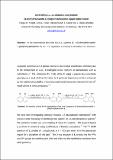Files in this item
Controlling Cu•••Cu distances using halides: (8-phenylthionaphth-1-yl)diphenylphosphine copper halide dimers
Item metadata
| dc.contributor.author | Knight, Fergus R. | |
| dc.contributor.author | Fuller, Amy L. | |
| dc.contributor.author | Slawin, Alexandra M. Z. | |
| dc.contributor.author | Woollins, J. Derek | |
| dc.date.accessioned | 2011-04-01T11:01:03Z | |
| dc.date.available | 2011-04-01T11:01:03Z | |
| dc.date.issued | 2009 | |
| dc.identifier | 4637430 | |
| dc.identifier | 4f75efb9-a6af-4e04-aa08-274ad471eeb5 | |
| dc.identifier | 000270593400003 | |
| dc.identifier | 74249112692 | |
| dc.identifier.citation | Knight , F R , Fuller , A L , Slawin , A M Z & Woollins , J D 2009 , ' Controlling Cu•••Cu distances using halides: (8-phenylthionaphth-1-yl)diphenylphosphine copper halide dimers ' , Dalton Transactions , no. 40 , pp. 8476-8478 . https://doi.org/10.1039/b916692k | en |
| dc.identifier.issn | 1477-9226 | |
| dc.identifier.other | ORCID: /0000-0002-9527-6418/work/56861795 | |
| dc.identifier.other | ORCID: /0000-0002-1498-9652/work/31779271 | |
| dc.identifier.uri | https://hdl.handle.net/10023/1762 | |
| dc.description.abstract | In the isomorphous binuclear Cu2X2L2 systems (L = (8-phenylthionaphth-1-yl)diphenylphosphine the Cu center dot center dot center dot Cu separation is reduced as the halide size increases. | |
| dc.format.extent | 3 | |
| dc.format.extent | 480072 | |
| dc.language.iso | eng | |
| dc.relation.ispartof | Dalton Transactions | en |
| dc.subject | Polyaromatic hydrocarbon ligands | en |
| dc.subject | Crystal-structure | en |
| dc.subject | Spectroscopic characterization | en |
| dc.subject | Substituted naphthalenes | en |
| dc.subject | Heterocyclic thiones | en |
| dc.subject | Platinum complexes | en |
| dc.subject | C-2 carbon | en |
| dc.subject | Thiosemicarbazones | en |
| dc.subject | Mononuclear | en |
| dc.subject | Chloride | en |
| dc.subject | QD Chemistry | en |
| dc.subject.lcc | QD | en |
| dc.title | Controlling Cu•••Cu distances using halides: (8-phenylthionaphth-1-yl)diphenylphosphine copper halide dimers | en |
| dc.type | Journal article | en |
| dc.contributor.sponsor | EPSRC | en |
| dc.contributor.institution | University of St Andrews. School of Chemistry | en |
| dc.contributor.institution | University of St Andrews. EaSTCHEM | en |
| dc.identifier.doi | https://doi.org/10.1039/b916692k | |
| dc.description.status | Peer reviewed | en |
| dc.identifier.grantnumber | EP/D061768/1 | en |
This item appears in the following Collection(s)
Items in the St Andrews Research Repository are protected by copyright, with all rights reserved, unless otherwise indicated.

